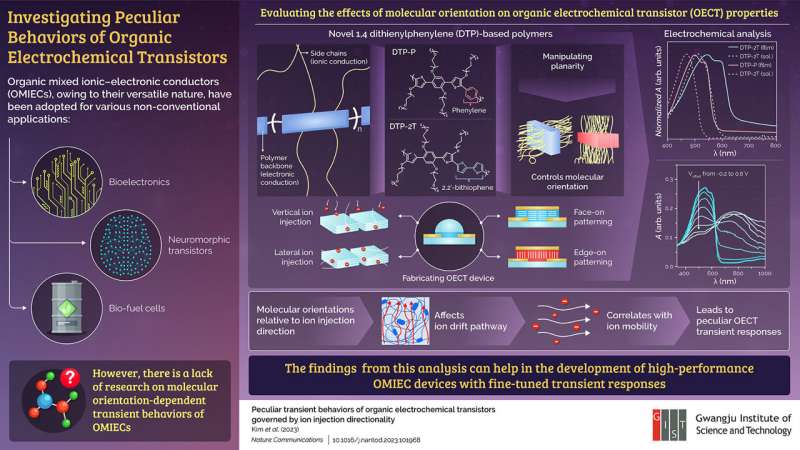This article has been reviewed according to Science X's editorial process and policies. Editors have highlighted the following attributes while ensuring the content's credibility:
fact-checked
peer-reviewed publication
trusted source
proofread
Researchers investigate strange transient responses of organic electrochemical transistors

Organic mixed ionic–electronic conductors (OMIECs) are a highly sought-after class of materials for non-conventional applications, such as bioelectronics, neuromorphic computing, and bio-fuel cells, due to their two-in-one electronic and ionic conduction properties.
To ensure a much wider acceptance of these fascinating materials, there is a need to diversify their properties and develop techniques that allow application-specific tailoring of the features of OMIEC-based devices.
A crucial aspect of this process is to develop strategies for evaluating the various properties of these materials. However, despite the increasing popularity of OMIECs, there is a severe lack of research on the molecular orientation-dependent transient behaviors of such conductors.
Now, however, an international team of researchers from Korea and the U.K., led by Professor Myung-Han Yoon from the School of Materials Science and Engineering at Gwangju Institute of Science and Technology, set out to bridge this gap in our understanding of organic mixed ionic–electronic conductors.
In their recent study published in Nature Communications on 28 November 2023, the team explored peculiar transient behaviors of OMIECs governed by variations in molecular orientation with the help of an organic electrochemical transistor (OECT).
In the past, several studies have already investigated OMIECs using the OECT platform, suggesting that various factors, such as direction, length, side chain symmetry, polymer backbone structure, and film crystallinity, modulate the properties of OECTs.
"OECTs are known to mimic the computing mechanisms of neurons and synapses in spiking neural networks (SNNs) and are thus considered promising," explains Prof. Yoon. "To aid the growing interest in exploring the dynamic behaviors of OECTs at the frequency domain, we focused on an aspect that is often overlooked. We decided to investigate the correlation between backbone planarity-dependent molecular orientation and transient OECT characteristics."
To this end, the researchers first synthesized two new 1,4-dithienylphenylene (DTP)-based OMEICs, DTP-2T and DTP-P, with co-monomer units, 2,2'-bithiophene and phenylene, respectively. The polymers comprised the same ionic and electronic properties, but by manipulating the polymer backbone planarity, the researchers were able to control the dominant molecular orientation of the mixed conductor system.
The DTP polymer was then used to fabricate OECT devices, which were subjected to electrochemical analysis. Initially, the team found that both polymers showed similar electrochemical properties despite having different molecular orientations. They then changed the ion injection direction when there was a certain current/voltage during the analysis.
They observed that ion injection direction relative to the molecular orientation affected the length of the ion drift pathway, which, due to an indirect correlation with ion mobility within the polymers, resulted in peculiar transient responses in OECT devices.
The findings of this study provide a unique perspective into the world of molecular orientation-dependent characteristics of OECT devices. "OECT-based SNN architectures are anticipated to replace current computing systems in the future by increasing computation speed and reducing energy consumption. Our findings are expected to facilitate the realization of SNN-based computing systems soon," concludes Prof. Yoon.
In addition, the team also believes that the insights from this study could facilitate the design and development of advanced organic mixed conductor materials for biomolecular and biosignal sensors.
More information: Ji Hwan Kim et al, Peculiar transient behaviors of organic electrochemical transistors governed by ion injection directionality, Nature Communications (2023). DOI: 10.1038/s41467-023-42840-z





















